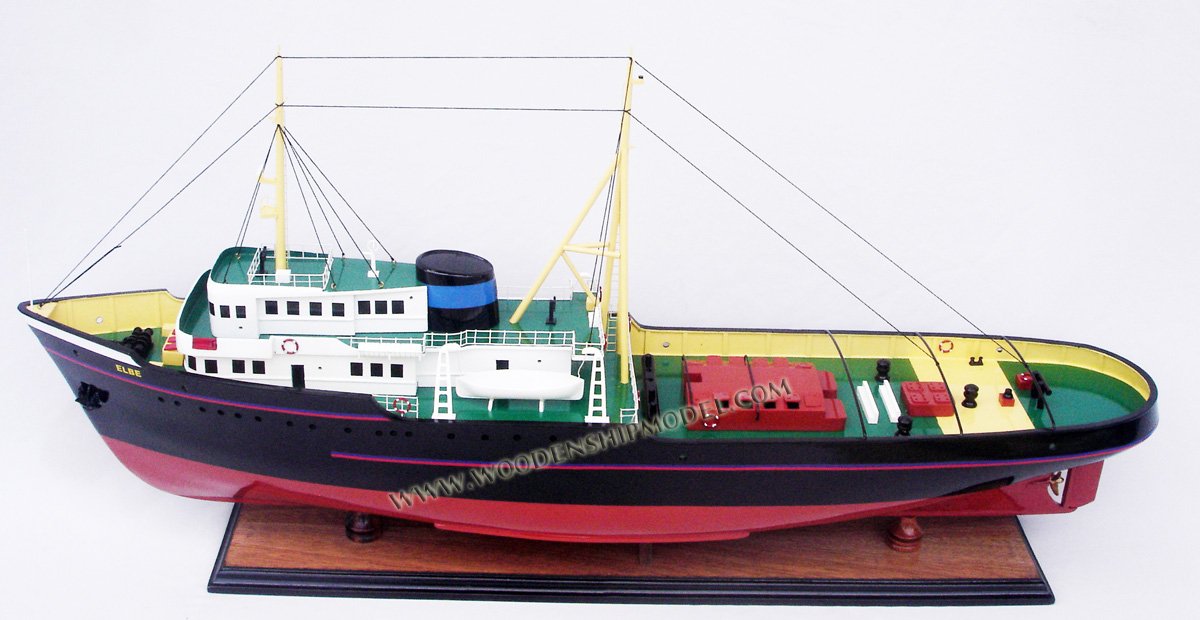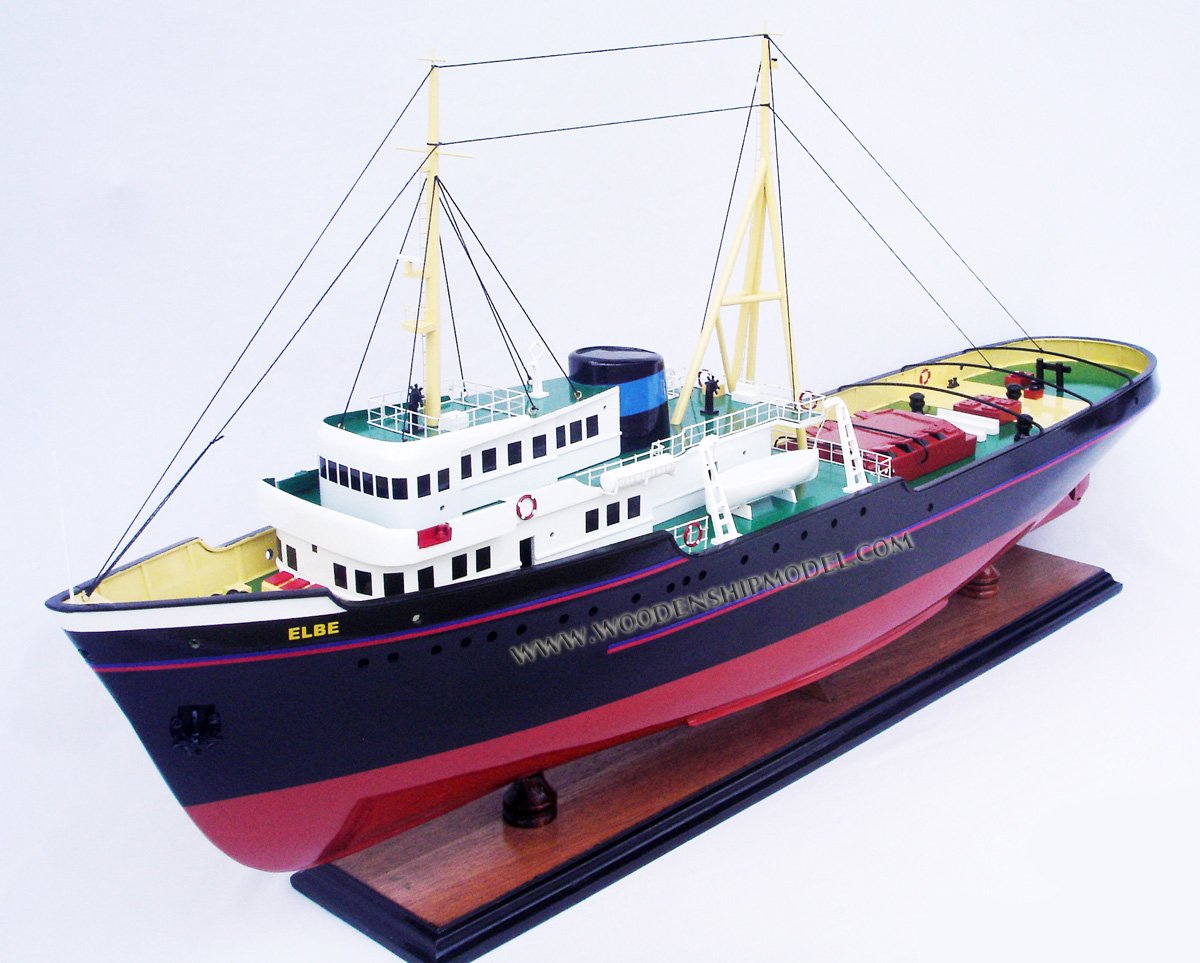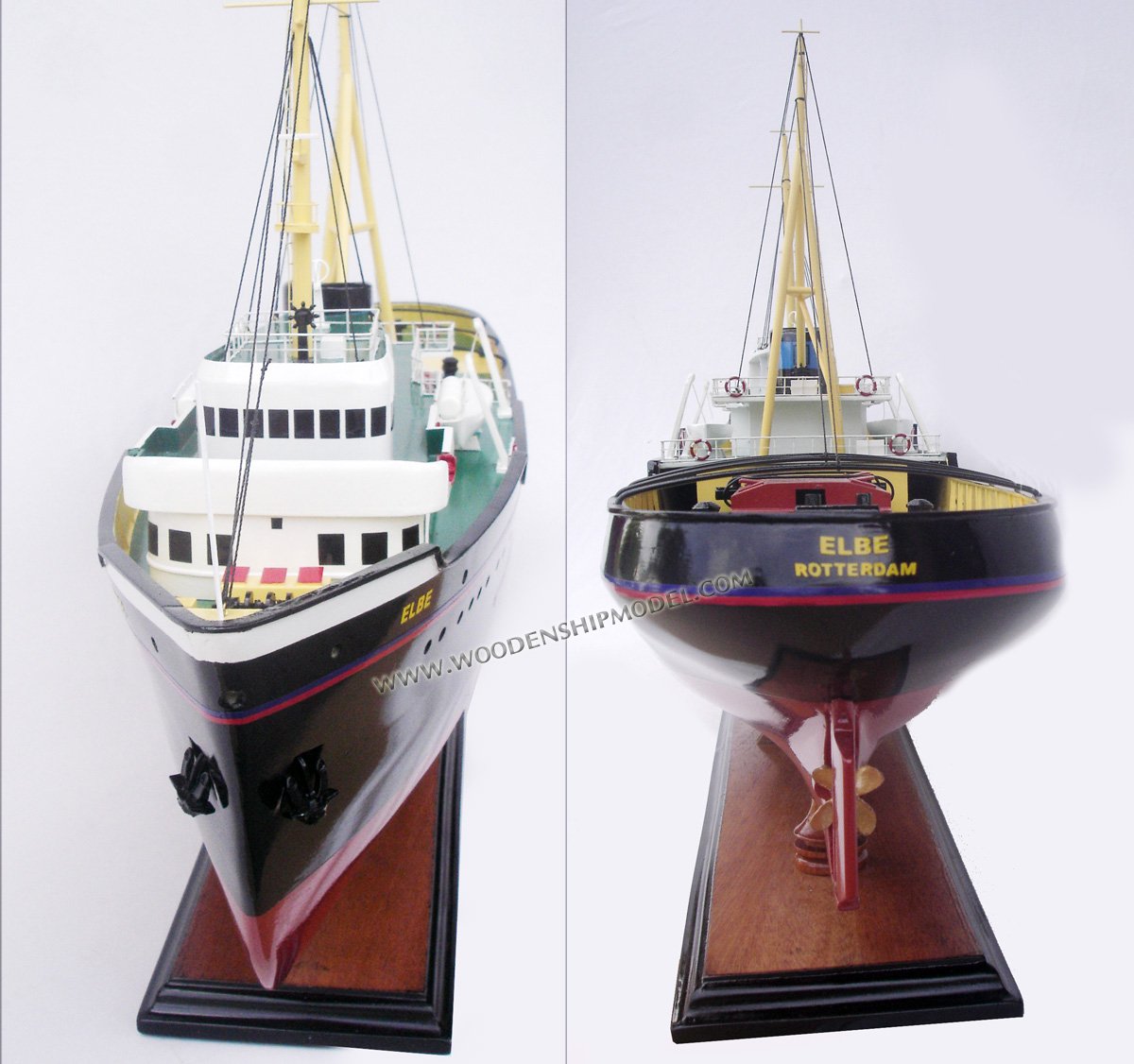|
HISTORY
As from February 24, 1959
until today, the Elbe made towing- and shipping history. It
all started with a days during fog, which threatened the
trial and the hand over to the owners. The hand over could
yet take place, thanks to an unexpected but powerful spring
sun that expelled the fog and so, the ship’s career could
start. Her first towing job, under captain A. Poot’s
command, was only a short trip. Passenger ship Victoria was
towed from Flushing to Rotterdam in 10 hours time.
Later, bigger jobs followed.
From salvage station Fayal on the Azores, the German tanker
Richard Kaselowsky, which couldn’t get anywhere due to a
broken crankshaft, was picked up and delivered to Hamburg by
the Elbe. During Pentecost in 1959, the Elbe, together with
2 other tugs, the Tasman Zee and the Schelde, towed the
famous Admirality Floating Dock from Portsmouth to the
Rotterdam Dockyard Company. This was a very appealing job
that dominated the presses for days. Still in 1959, the Elbe
towed two aircraft carriers from Boston to Antwerp. Further,
the severely damaged Africa Queen was towed in ten days from
Lisbon to the Flushing roads. Her first survey, after 4
years in service, was not hasted. Improvement to the exhaust
gas turbines for charging, plus the installation of air
coolers, resulted into a higher charging pressure. The
engine output increased therefore from 4000 to 4500
horsepower. Until the Zwarte Zee (IV) came into service in
1963, the Elbe was during a short period the most powerful
tug in the world. Due to the decreasing demand for heavy
duty sea-going tugs, L. Smit & Co’s Internationale
Sleepdienst decided to plan and order the sisters Clyde and
Elbe. Heavy duty, at that time, because the most powerful
tug until then was still the Zwarte Zee (III), with 4200
horsepower already more than 2 decades an example of power.
The two planned sisters should be able to match the power of
the flag ship.
In 1976, Smit decided to push
off the Elbe and offered her for sale. One of the terms was
that she would not get into the hands of a rival. When the
Elbe was rebuilt to pilot cutter, where, of course the
towing winch was removed, she would be heading into a bright
new future.
On one of the last towing
jobs, the Elbe is towing a pontoon from Algeciras in Spain
to Felixstowe in England. Some smaller jobs on the North Sea
follow, whereafter the ship is being prepared for the voyage
to Cork in Ireland. Chief Engineer A.J. Dijker is the last
man on board. He takes the ship with a temporary crew to
Ireland. At the Verolme ship yard in Cobe, the Elbe is being
thoroughly rebuild.
During rebuilding the ship,
the Elbe isn’t obviously a tug anymore. Besides the removal
of the towing winch, also the [sleepbogen] and the engine
room hatch are being removed. Also, the boat deck is being
expanded up to the capstan on the poop deck. Extra crew
quarters are being created for the pilots and the sloops are
being placed to the aft. Also, the bridge deck is being
expanded and the [berghout] is being cut away. However,
during rebuilding the ship, the original interior is
retained. Later, during restoring the vessel, this turned
out to be a blessing for the ship as well as for her crew.
Under her new name Maryland,
the Elbe serves during nine years as pilot cutter off the
coast of the United States. The ship is here also praised
for her seaworthiness as she appears to behave extremely
well on rough seas. However, The Association of Maryland
Pilots decides to hand her over to Greenpeace in 1985. At
that moment, the environmental organization is looking for a
firm ship for campagnes, mainly in Arctic waters.
In 1985, The Association of
Maryland Pilots decided to donate her pilot cutter Maryland
to the environmental organization Greenpeace. As a result,
the original Elbe was even rebuilt more, with hydraulic
cranes for launching the well known inflatable rubber boats
and she got equipped with a helicopter deck for air support
when finding her way through the ice. As the Elbe was not
built as an ice class vessel, Greenpeace added 17 mm extra
steel to her bow, however, assistance of a helicopter was
still very welcome.
After many years of absence,
the Elbe was welcomed back in Rotterdam on January 4th,
2002. For the first time since September 1976, the ship
returned under the name Elbe, and with a blue painted band
on the funnel.
The ship’s first berth was at
the Wilton harbour in Schiedam. At this place, restoration
made start. The windlass was overhauled and the foremast was
brought back in original condition, also without crow’s
nest, among others. The widened bridge deck, with a covered
sloop deck, was modified and with the removal of the
helicopter deck, the Elbe regained the first lines of a sea
going tug.
During spring 2003, the Elbe
is start ship for the Heineken Race of the Classics, that
year she also participated in the Furieade. In 2004 there
was an open house at Alphatron, which was also the reunion
of radio operators of Radio Holland, with the commissioning
of the, also, restored, radio station. Later that year she
also attended the boat parade at the 25 year anniversary of
the National Towage Museum Maassluis. In October 2003 and
April 2004, the Elbe returns to her original home port
Maassluis. Until July 30, 2004, when doom strikes: heavy
transport ship Fairpartner runs into the Elbe, with her
bulbous bow right into her engine room. The Elbe sinks
within minutes.
The ship is being salvaged en
repaired in Vlaardingen. The Elbe is the last ship that
docks at shipyard HVO. After that, the shipyard will close.
On October 27, 2004, the Elbe at that moment, is moored at
Wärtsilä in the Wilhelmina harbour in Schiedam, the Elbe
sinks again. This time it is an act of sabotage. Many
volunteers see all the hard work they put in for many months
literally disappear under water, but they hold on to their
dream. The Elbe is being saved from demolition and
restoration continues!
On Saturday February 12,
2005, the Elbe returns to her original home port, Maassluis.
With 3 degrees celsius and windforce 8 to 9 south west, the
ship gets a warm welcome of hundreds of interested persons.
The continuation of the restoration is larger than ever. The
engine room is being overhauled completely, all cabling in
the ship is being replaced, the interior is being
disassembled mostly. The ship is being re-isolated
completely, tank tops replaced, the in 1976 removed [berghout]
is being restored completely. Also, the rear mast is being
overhauled and placed back. The bulwark on the poop deck is
being replaced and the bridge wing at the rear mast is
placed back. The hood of the engine room is being renewed
and the [beting] is being placed back on the poop deck.
All this work make the Elbe a
real sailing ship that, in 2013, fully regained her shine as
sea going tug. Autumn 2013, the Elbe receives her
certificates, proving she is a real sailing ship.
Source
Museum info:
Address: Govert van
Wijnkade 44, Maassluis, Netherlands
Phone:
+31 6 51562210
|











